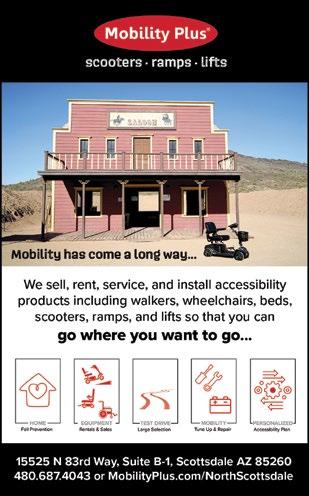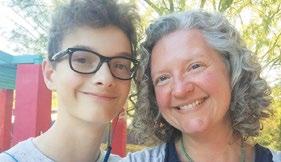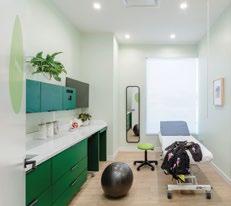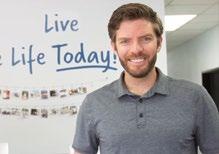
10 minute read
Health
Anna Lunaria, MsAc. L.Ac. CMT CYT CHT Specializing in Chronic Pain & Autoimmune • 26 years of experience
Are you ready to feel better naturally? Book Now! $10 o New Patients
Feel Better with Acupuncture

“Anna has been instrumental in helping manage my autoimmune chronic pain and fatigue. She is truly a miracle worker and I am incredibly grateful for her.” A.S.
“Anna worked on my Rotator Cu , my Hip, and the Neuropathy in my feet. All of these have shown signi cant improvement. I recommend Anna to everyone I come in contact with.” J.K.
Yin Rising Acupuncture has two locations:
North Phoenix 10880 N 32nd St Suite 15 (& Shea) Tempe 6101 S Rural Rd Suite 112 (480) 206-6199 Call/Text www.yinrising.com Book Online
Health Timely Health Updates From Local Experts
May is National Skin Cancer and Melanoma Awareness Month and Stroke Awareness Month. We checked in with local health experts to find out more about these two important health issues.
NATIONAL SKIN CANCER AND MELANOMA AWARENESS MONTH
Information Courtesy of Justin Moser, M.D. Did you know that more people are diagnosed with skin cancer each year in the U.S. than all other cancers combined? You might think it’s unlikely to affect you until you’re older, but one specific type of skin cancer – melanoma – is one of the most common cancers you’ll find even among young adults. Melanoma also accounts for a large majority of skin cancer deaths due to its aggressive nature.
Especially in the hot and sunny climate we enjoy here in Arizona, skin cancer and melanoma deserve our attention. The best thing you can do for your skin is wear a good SPF sunscreen (30 or greater) that protects your skin against UVA (aging rays) and UVB (burning rays). Put it on every couple of hours that you’re outside – even if it’s cloudy.
With proper care and monitoring, you can prevent skin cancer or catch it early, which lessens the chance you’ll be dealing with an advanced stage of cancer. That’s why it’s important to keep an eye on your skin for anything suspicious, and why getting regular skin checks from a dermatologist is so critical.
It’s recommended that you begin annual skin screenings in your 20s or 30s, but if you’re in the sun a lot or have a family history of skin cancer, you should talk to your doctor about being screened sooner. The good news is that proper screenings catch skin cancers earlier. The earlier skin cancers are treated, the higher the chance of a cure. Even with melanoma, if it’s detected early, the five-year survival rate is 99%. become damaged or die. Every minute counts when a stroke is suspected.

Stroke affects about 800,000 people in the U.S. each year. Risk factors commonly associated in older adults, such as hypertension, diabetes, tobacco use and obesity are now being seen in younger stroke patients, according to Lisa Ziomek, Stroke Care Coordinator at Abrazo Central Campus.
More than 87 percent of strokes in the U.S. are ischemic strokes, caused by a clot that cuts off blood flow to a part of the brain. These types of strokes are largely treatable if a patient gets to a hospital that can provide the right treatment in time.
The U.S. Centers for Disease Control and Prevention (CDC) offers a simple test to act FAST if you think someone may be having a stroke: • Face – Ask the person to smile, does one side of the face droop? • Arms – Can the person raise both arms? Does one arm drift downward? • Speech – Ask the person to repeat a simple phrase. Is the speech slurred or strange? • Time – If you see any of these signs, call 911 right away.
Also, note the time when the symptoms first appear, this helps health care providers determine the type of treatment needed.
Justin Moser, M.D., is with HonorHealth Research and Innovation Institute Melanoma Clinic.
STROKES NEED FAST RESPONSE: MAY IS STROKE AWARENESS MONTH
Information Courtesy of the Comprehensive Stroke Center at Abrazo Central Campus Did you know that stroke has no age limits, and younger adults are increasingly affected by stroke and its risk factors? Strokes happen when blood supply to part of the brain is blocked or when a blood vessel in the brain bursts. In either case, parts of the brain
Health
Tia Phoenix Serves Women At Its New Location at Kierland Commons
Information and Photos Courtesy of Tia
Tia is the modern medical home for women, offering gynecology, primary care, mental health, and wellness through a blend of in-person and virtual services. Tia opened the doors of its Phoenix/Scottsdale location at Kierland Commons recently and considers the move, “A hallmark moment for us to extend Tia’s signature whole-person healthcare experience beyond the coasts into a third city,” according to the practice.
TIA’S HEALTHCARE OFFERINGS INCLUDE:
• Gynecology and Primary Care: PAP, family planning, birth control counseling, general consultations, prescription refills, blood work, and more. • Mental Health: Therapy, medication management, and mental health checkups at every annual Whole Health
Exam visit. • Wellness: Acupuncture, cupping and massage services. • Coming Soon: Fertility planning.
From New York City to Los Angeles and now the Phoenix/Scottsdale area, Tia accepts as many insurance plans as possible, which covers core offerings like their signature Whole Health Exam. And in Arizona — in partnership with Dignity Health — Tia is accepting Medicaid for the first time, making their care more accessible to more people, cites the practice.
“Tia’s all about collaboration — yes, with our healthcare, but also with our community! We’re looking to you, our new friends in Phoenix, to tell us what you want from your modern medical home,” according to the practice. “From local artists we can feature in the clinic, to community programming and events you’d like to see, to local healthcare activists and organizations we should uplift and partner with — we’re here to serve, and we can’t wait to meet you!”
Tia Phoenix is located at 15051 N. Kierland Blvd., Suite #200 FB1. Learn more at asktia.com/locations/tia-phoenix.


Why You Still Have Back Pain
(And How To Get Rid Of It For Good)
• By Leading USA Back Pain Expert, Dr. Tom Padilla
Is doing everyday things from tying your shoes to nding a comfortable sleeping position di cult because of back pain? You may nd it hard to enjoy those around you because you’re in pain. You may
have already tried “everything,” but the di culty is nding the things that will help and actually
last. It seems like even things that help are only temporary xes. Maybe you’ve started to think you just have a “bad back.”
Back pain isn’t caused by a “bad back.” And it’s not xed by stretching or surgery or painkillers. Back pain is caused by fatigued, overworked muscles that have to work overtime because your brain has stopped using your smaller stabilizing muscles to do their jobs. e problem is in the communication
between your brain and your body.
is is the reason so many of the “solutions” we try only provide temporary relief–they’re not targeting the root cause. And without getting to the source of the problem, back pain will continue to return because the cause was never addressed.
So how do you x back pain? You retrain the brain. Exercises that remind your brain which muscles to use and in what order keep the pain from returning (and getting worse).
If you’re active and conventional advice like resting and “taking it easy” isn’t working for you, you don’t
have to choose between surgery and giving up the activities that you love.
You’ve likely already tried many di erent things. Usually the list includes massage, stretching, chiropractic, and di erent exercises. One of my patients, Shelley, had tried everything above and was getting ready to see a surgeon because none of it lasted.
Shelley told me, “Regular household tasks like
mopping, vacuuming, putting sheets on the bed, etc., became things that would randomly set o my back and put me in bed for several days.”
Eighty percent of back pain is reversible. No matter how long you’ve su ered, you can still get your life back. No surgery. No pills.
e core issue, which has been proven time and again in the best research, is that the brain has
developed new ways of moving your body to
protect itself after injury. After a while, these new patterns become hardwired into the brain. No matter what you do to relax the muscles, the pain will continue unless you x the patterns your brain is using. is pattern is what CAUSES back pain. ese muscles get called on to do everything, from stabilizing the skeleton to moving the body, when your body is designed to spread the burden of these tasks across a variety of muscles. When the smaller muscles aren’t doing their jobs, the brain recruits the big muscles to take on the task and they quickly become tired and overworked.
e 7 Most Common “Fixes”... at Don’t Work Long Term
1. Stretching: It helps for a little bit, but the pain will keep coming back because it doesn’t address the root cause of the pain. 2. Hot-packs or hot showers: ese feel good in the moment and help get blood- ow to the muscles, but are only temporary xes. 3. Massage: It felt good for a few days but then it came back. 4. Chiropractic care: It eased the pain a bit, but the nagging sensation is still there. 5. Painkillers: You went to the doctor’s o ce, and they gave you pain meds and told you to come back in 6 weeks if it didn’t work. 6. Physical erapy: You went to a physical therapist who put you on the same exercises everyone else with back pain gets…then they left you with an assistant who only half watched your technique.
Activities To Avoid
Here are 3 things that can make your back pain worse. Lollygagging: Believe it or not, your pace matters. When you’re browsing at the mall, you sway back and forth a little bit because you’re not really using your muscles. Have you noticed that the longer you casually browse, the more your back starts to hurt until you need to take a break? Crossing Your Legs: is is a biggie. When you cross your legs, it puts pressure on your spine, rotating or bending it to the side. Ignoring It: If this strategy hasn’t worked for you up until now, you’re not getting closer to a breakthrough. Trust me, there’s no prize for persistence in this category.

How to Fix Back Pain for the Long Term
ese days, Shelley is playing basketball with her boys again, exercising, and living her daily life without pain. After 20 years of chronic back pain, she was able to get back to the life she loved by correcting misalignment we found in her hips and re-teaching her muscles how to work (correctly) and strengthening them.
After hearing the game plan to get her back to her life, she said, “It sounded so simple and made so much sense.” She said, “It was such a relief to learn
that I didn’t have a lifelong condition that I just had to live with or attempt to x with surgery as I
had been told before!”
Shelley said she “was skeptical of physical therapy because of what I’d heard from others’ experiences, but I was ready to try anything. From my rst visit, I felt hopeful for the rst time in years that I could be active again and get over my chronic back trouble.”
Tips and Exercises to Crush Back Pain for Good
Our special back pain report is full of tips and exercises to ease your pain and change the way your brain works for the long term so you can get back to picking up your kids, playing your sports, or just tying your shoes. Get the report by calling or texting us at 480-482-0651 and asking for a copy, or emailing us at info@thedoctorsofpt.com and saying, “Send me a back pain report.”
Or, if you’d like to meet with one of our doctors one on one for a personalized diagnosis and roadmap to healing, ask us about our free discovery visits. Our doctors believe in teaching you about your body and nding an approach that works best for you.
To Apply For a Discovery Visit go to: www. thedoctorsofpt.com/discovery-session
Dr. Tom Padilla, Doctor of Physical erapy, author, and back pain expert, is the owner of e Doctors of Physical erapy in Scottsdale, Arizona and has helped thousands of people across the country get back to living the lives they love without pain.






